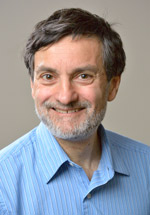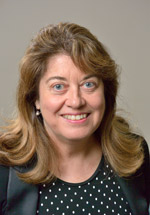Like many parents, scientists at the University of Illinois often see their children follow them into their chosen profession. William Bardeen, son of two-time Nobel Prize for Physics winner and Illinois faculty member John Bardeen, went on to become a renowned physicist at Fermilab.
So it is with many Beckman Institute researchers. Some of their children follow in the same discipline as their parents while others choose another field of study in science. Others make completely different choices in college while some take circuitous routes to a career once they leave the nest.
Beckman Institute researchers Tom Huang and Michael Insana each have four children, but while all four of Huang’s children began their college careers in their father’s field of electrical engineering, it wasn’t until his last child entered college four years ago that Insana saw one of his children follow in his footsteps.
Insana’s first three children chose diverse career paths – one is a recording engineer, another a teacher, and a third a computer programmer – but it wasn’t until his youngest, Greg, enrolled at Illinois that another engineer in the family looked like a possibility.
“Kids are all over the place,” Insana said. “They have the same genes and the same environment and yet they go off in dramatically different directions. How does that happen? I have no clue. I provided very little guidance in terms of where they wanted to go, just sort of encouragement for whatever it was they wanted to do.”
Still, he was happy that Greg chose a similar career path. Greg is a senior in Electrical Engineering and is set to graduate this coming May.
“He decided he didn’t like the biology side of things and I think you get those experiences in high school and taking classes,” Insana said. “But he always liked math and physics so I talked to him a little bit about electrical engineering, which seemed to be good for him.”
Insana said the Engineering and Beckman Institute open houses also played a role in his son’s choice of college majors.
“He came to two open houses while he was in high school and he got to go around and sense what everybody was doing,” Insana said. “And that was pretty influential.”
Insana, who is head of the Bioengineering department at Illinois and leader of the Bioimaging Science and Technology group at Beckman, said the Engineering program at Illinois is one of the best in the country and one of the most difficult. But it was a challenge his son rose to meet.
“It’s a tough school and the level of expectation goes way up,” Insana said. “So it was really enjoyable to see him come down, then pull up to where he is right now, feeling very good and confident. Things are going well. This place was really, really good for him, given his interests.”
While his oldest son is working in Nashville as a recording engineer, Insana’s other three children are nearby. In addition to Greg, his oldest daughter is a computer programmer in the Physics department at Illinois while his youngest daughter came here to earn a Ph.D. in Education after working as a teacher in San Diego.
“So I have three of my kids close by now, which is terrific,” Insana said.
Huang is the William L. Everitt Distinguished Professor in the Department of Electrical and Computer Engineering at Illinois and Co-chair of the Human-Computer Intelligent Interaction research theme at Beckman. While all four of his children began college in electrical engineering, Huang said only one is still in the field.
“I did not at all encourage them to study EE when they entered college, at least not explicitly,” Huang said.
Huang said that growing up, his children were interested in many different areas, so he’s not sure why they all originally chose electrical engineering to start college.
“For example, Thomas was good at math and sciences, but also an award-winning debater,” Huang said. “So making a choice is both easy and difficult, depending on one’s point of view. Then, perhaps they saw me really enjoying my work. I may have told them – I do not remember for sure – that no matter what you are going to do in life in the future, studying EE is always a good starting point.”
Huang said his daughter Caroline and son Gregory earned Ph.D.s at MIT in electrical engineering and computer science but Caroline is the only one who is still working in that area. Gregory works with a web-based technology and business reporting company while Thomas is an editor with the Dallas Morning News and daughter Marjorie is a housewife after earning a degree in labor relations.
“My wife and I are very happy and proud that our children are doing what they are passionate about, and doing well,” Huang said.
Researchers Gabriele Gratton and Monica Fabiani from Beckman’s Cognitive Neuroscience group are married and the parents of two daughters: Cristina, a senior at University High School who has an interest in biology, and Caterina, who is earning a Ph.D. at Cal-Berkeley in her parent’s field of neuroscience.
“I’m happy my daughters are going into the sciences but if they made another choice I would be happy just as well,” Gratton said. “I just think it’s nice to be able to talk to your children about many different things, including your work, your shared interests. Just as I like that they share my interest in soccer, I like that they share my interest in science.”
Fabiani was not expecting her oldest daughter to go into the field of neuroscience.
“We were very surprised because she kept telling us ‘anything but the brain’ growing up,” she said. “So that was a surprise.”
Sometimes researchers end up working with their children on projects. Benjamin Suslick, the son of Ken Suslick of the Bioimaging Science and Technology group, was lead author on a paper with his father for Analytical Chemistry that was written while Benjamin was still in high school. The paper described the development of a coffee analyzer that was able to distinguish between different varieties of coffee based on their aroma.
The project took “electronic nose” technology developed in his father’s lab and applied it to coffee, but it was Benjamin who led the effort. After years of Benjamin working in his father’s lab, doing mostly data analysis, Ken Suslick decided to let his son tackle a project.
“During his junior year Benjamin discovered coffee,” Suslick said with a laugh. “We could have had him work on toxic industrial chemicals but … ummm, high school student … toxic chemicals, maybe not a great idea, even if he is the boss’s son.”
The project earned Benjamin a semifinalist award in the Intel Science Talent Search, a high-level science research competition for high school seniors.
“I’m exceedingly proud of Ben,” Suslick said.
During her undergraduate days at Illinois, Caterina Gratton worked with researcher Kara Federmeier, also of the Cognitive Neuroscience group. Fabiani said it was good for a budding scientist like her daughter to begin her research career with someone other than her parents.
“She needs her independence from us,” Fabiani said.
But a collaboration could still happen once Caterina earns her Ph.D.
“It would be fun if it happened but there are no plans for it right now,” Fabiani said. “That would be fun though. We could look forward to a paper with Gratton, Gratton as authors. Our youngest daughter is interested in biology so maybe we would have two eventually.”


